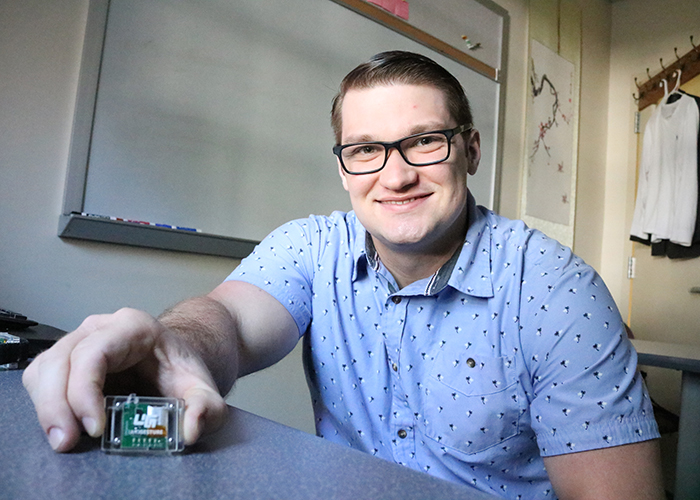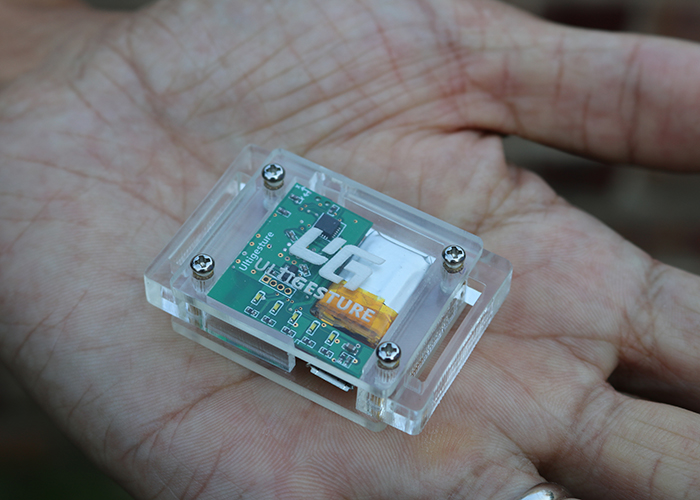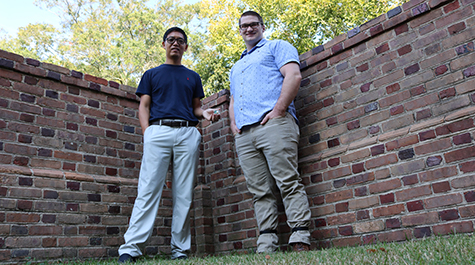Interdisciplinary research team treating Parkinson’s symptoms with artificial intelligence
In science there is a term called “ground truth,” the baseline from which data is judged for accuracy. For William & Mary student Ken Koltermann, the term may better be described as “boots-on-the-ground truth.”
The third-year Ph.D. candidate in computer science spent five months of the pandemic walking nearly two hours at a time to collect data on his gait – data that a team of researchers from W&M and Virginia Commonwealth University are using to develop a novel treatment for a potentially dangerous symptom of Parkinson’s disease called Freezing of Gait (or FoG) – the temporary inability to move while walking.
“I volunteered for it,” Koltermann said. “I thought, if I'm leading the data collection for this project, I have to do it myself.”
It was hard work – and it was personal.
 “My late grandmother actually suffered from Parkinson's and her cases were extremely bad,” he said. “She had Freezing of Gait episodes where she would have frequent falls, which, as you get older, become more and more serious. It gets easier to break bones, to suffer real injury. She’s the number one reason I got involved in this research.”
“My late grandmother actually suffered from Parkinson's and her cases were extremely bad,” he said. “She had Freezing of Gait episodes where she would have frequent falls, which, as you get older, become more and more serious. It gets easier to break bones, to suffer real injury. She’s the number one reason I got involved in this research.”
There is currently no cure for Parkinson’s disease, Koltermann explained, only treatments like medications and a surgery procedure called deep brain stimulation, which only helps to suppress some of the symptoms rather than cure the disease.
Koltermann is part of an interdisciplinary research team made up of fellow W&M graduate students Woosub Jung and Minglong Sun, W&M Professor of Computer Science Gang Zhou, Ingrid Pretzer-Aboff, associate professor and senior nurse researcher at the VCU School of Nursing, and Leslie Cloud, associate professor of neurology at the VCU School of Medicine and director of VCU’s Parkinson’s Disease Program.
The team is developing an innovative new treatment for the movement-related symptoms of Parkinson’s disease, which affects more than 10 million people worldwide. The treatment uses a combination of hardware and software to administer targeted vibrations in reaction to certain Parkinson’s symptoms, such as tremors and FoG.
“Within this team, we have two devices, one developed by Resonate Forward, LLC, and the other co-developed by W&M computer scientists,” Zhou said. “We’re using our combined expertise to design software to communicate with the hardware and develop an effective treatment. It’s a totally interdisciplinary project.”

The project was recently awarded funding from the National Institute of Neurological Disorders and Stroke at the National Institutes of Health. Zhou explained that the research is filling a critical gap in the way Parkinson’s disease is understood and treated. Freezing of Gait is a common yet devastating manifestation of the disease, he said, and it’s a symptom of the disease for which there is no cure or adequate medical or surgical treatment.
“Freezing of Gait can be very isolating socially. It’s very burdensome, or at least taxing, on family members that have to help their loved ones. It affects their psyche through the fear of falling,” said Pretzer-Aboff, who has studied vibration therapy in Parkinson’s patients for more than a decade. “There are very few choices out there to help patients like this. We’re hoping that using vibration in this new way will show better results and give people some hope, a little more autonomy, freedom and a better quality of life.”
FoG episodes are frequently triggered by environmental and psychological factors, such as starting to walk, walking through tight quarters, changing directions, approaching a visual target and dual tasking, she explained. Stressful, time-sensitive situations, such as entering an elevator before the doors begin to close, can also trigger a FoG event.
“Each individual with Parkinson’s disease is unique with regard to how sensitive they are to these various triggers, underscoring the need for customized therapeutic approaches,” the researchers wrote in their grant proposal to NIH. “As such, increased understanding of modifiable factors underlying FoG and increased understanding of individual nuances in experiences of FoG is warranted.”
The nuances of an individual’s gait are not an easy thing to classify. Just ask Koltermann. From August through December of 2020, he regularly traveled up to VCU’s physical therapy clinic to collect real-time walking data on himself for the study’s baseline, using the university’s Protokinetics ZenoTM Walkway – a non-portable, gait-monitoring mat that is currently in widespread clinical use for collecting data on how people walk.
 He also wore an UltiGesture band. It’s a quarter-sized piece of hardware co-developed by Zhou’s lab that carries an accelerometer and gyroscope that collect data, which is transmitted to a smartphone via Bluetooth. Artificial intelligence, also developed by Zhou’s lab, is embedded in an app on the smartphone, which analyzes the data to detect a baseline gait and any abnormalities in it.
He also wore an UltiGesture band. It’s a quarter-sized piece of hardware co-developed by Zhou’s lab that carries an accelerometer and gyroscope that collect data, which is transmitted to a smartphone via Bluetooth. Artificial intelligence, also developed by Zhou’s lab, is embedded in an app on the smartphone, which analyzes the data to detect a baseline gait and any abnormalities in it.
“I was walking for upwards of 90 minutes at a time with our device mounted on my ankles, just collecting data and comparing it to what we got from the mat,” Koltermann explained.
As it turned out, the data he collected was more than enough for the team to be able to begin classifying the various elements of an individual’s gait. Once he had collected enough data on his own gait, Koltermann turned to artificial intelligence to take the next steps. He and the team developed a type of machine learning to classify how he walked.
“Once that was done, we could confirm that we could accurately detect my gait with our device,” Koltermann said.
Zhou explained that validating the hardware and software was a huge milestone. The team’s UltiGesture device is highly portable and costs about $10. The gait-detection AI they developed can operate on smartphones, which are also highly portable and widely available. Compare that to currently available gait mats, which are only accessible in clinical or research environments and costs upwards of $50,000.
“If we can show our device is as accurate as the mat, that could lead to a revolution in healthcare accessibility – and not just for Parkinson’s,” Koltermann said. “This will make gait analysis so much more accessible, especially for rural healthcare systems and low-income areas.”
The next phase in the research is to pair the UltiGesture system with the VibeForward device, a small piece of hardware developed by Resonate Forward, LLC, that delivers localized vibrations to the ankle and foot to prompt movement in those experiencing trouble walking or stabilizing themselves.
“This technology has great potential to give patients who have Freezing of Gait their independence back,” Brian Berman, director of VCU’s Parkinson’s and Movement Disorders Center, said in a press release. “Our researchers continue to strive to find ways to significantly improve the lives of those with Parkinson’s disease until a cure can be found.”
Together, the UltiGesture and VibeForward device will eventually be able to sense the slightest hint of Freezing of Gait in a patient’s walk and trigger the ankle device to vibrate — within a second — to help the wearer stay in motion as usual.
“The current treatments available for Parkinson's disease reduce symptoms, but they don't remove the real-time danger of falling from Freezing of Gait,” Zhou explained. “This system will be able to differentiate between intentional stopping and the involuntary stopping from Freezing of Gait, and then it will be able to provide instant vibration treatment.”
There’s also another element of the research, which Zhou says is still in very early stages, but could open up an entirely new realm of possibilities. His team plans to integrate environmental stimuli into data fed to the artificial intelligence, making it possible to sense possible triggers for Freezing of Gait, such as doorways and elevators.
“It’s really about providing Parkinson’s patients a new level of freedom to navigate the world safely,” Zhou said. “With our environment-dependent classification framework, they will be free to navigate potentially triggering stimuli with far less risk of injury. We are marking the environment for them, adjusting our algorithm to reconfigure and deliver the right dose of the vibration based on that environment. Giving patients that element of freedom, that’s a motivating factor here.”
















